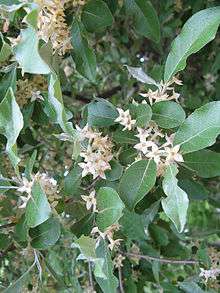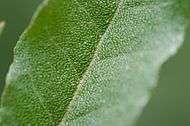Elaeagnus umbellata
| Elaeagnus umbellata | |
|---|---|
 | |
| Scientific classification | |
| Kingdom: | Plantae |
| Clade: | Angiosperms |
| Clade: | Eudicots |
| Clade: | Rosids |
| Order: | Rosales |
| Family: | Elaeagnaceae |
| Genus: | Elaeagnus |
| Species: | E. umbellata |
| Binomial name | |
| Elaeagnus umbellata Thunb. | |
Elaeagnus umbellata is known as Japanese silverberry,[1] umbellata oleaster,[2] autumn olive,[1][3] autumn elaeagnus,[3] or spreading oleaster.[3] The species is indigenous to eastern Asia and ranges from the Himalayas eastwards to Japan. Because it fixes atmospheric nitrogen in its roots, it often grows vigorously and competitively in infertile soils.[4]
Description
Elaeagnus umbellata grows as a deciduous shrub or small tree, typically up to 3.5 metres (11 ft) tall, with a dense crown.[5] It commonly bears sharp thorns in the form of spur branches.[5] Flowers are fragrant and occur in clusters of white to yellow, 8-9 mm in length and 7 mm in diameter, and have four lobes.[5]
The leaves are alternate, 4–10 cm long and 2–4 cm wide with wavy margins. The leaves are covered with minute silvery scales when they emerge early in spring,[5] but turn greener above as the scales wear off during the summer. The underside is more intensely covered in the silvery scales, differing from the related E. angustifolia, which remains silvery until it sheds its leaves in the fall.
The red fruits are pulpy, juicy and sweet, 3-9 mm in length, 5 mm in diameter, and average 137 milligrams in weight, with a thin skin covering the whole fruit.[5]
Flowers
The flowers are borne in the leaf axils in clusters of 1-7. They are pale yellowish-white, fragrant, (often heavily fragrant) and have a four-lobed corolla 1 cm long. The fruit is a small round drupe 1/4 to 1/3 inches (0.65 to 0.85 cm) in diameter.[6] The unripe fruit is silvery-scaled and yellow. It ripens to red, dotted with silver or brown.
Fruit
When ripe, the fruit is juicy and edible, and also makes a good dried fruit. Though the fruit are small, the tree bears them abundantly. They are tart-tasting, with chewable seeds. Their content of the carotenoid, lycopene, is some seven to seventeen times higher than that of tomatoes.[7]
Naturalization and invasiveness
In some parts of North America where it has become naturalized, Elaeagnus umbellata is considered an invasive species.[8][1] It is considered a "prohibited noxious weed" under the Alberta Weed Control Act 2010.[9] In Great Britain, it does not seem to be invasive: it was introduced to Britain in 1829 and the first wild occurrence was noted almost 150 years later in 1971.[10]
| Wikimedia Commons has media related to Elaeagnus umbellata. |
References
- 1 2 3 Species Profile – Autumn Olive, National Invasive Species Information Center, National Agricultural Library. Lists general information and resources for Elaeagnus umbellata.
- ↑ Black B, Fordham I (2007). "Autumn olive: weed or new cash crop?" (PDF). New York Berry News. Retrieved November 1, 2013.
- 1 2 3 "USDA GRIN Taxonomy".
- ↑ J.R. Clark, G.E. Hemery, and P.S. Savill. Early growth and form of common walnut (Juglans regia L.) in mixture with tree and shrub nurse species in southern England. Forestry (2008) 81 (5): 631-644 first published online September 5, 2008 doi:10.1093/forestry/cpn036
- 1 2 3 4 5 Parmar, C. and M.K. Kaushal. 1982. Elaeagnus umbellata. p. 23–25. In: Wild Fruits. Kalyani Publishers, New Delhi, India. NewCROP, New Crop Resource Online Program, Purdue University
- ↑ Dirr, M. 1998. Manual of woody landscape plants : their identification, ornamental characteristics, culture, propagation and uses. Stipes, Champaign, Ill.
- ↑ Fordham, IM, Clevidence BA, Wiley ER et al. "Fruit of autumn olive; A rich source of lycopene" HortScience. Alexandria 36:1136-1137, 2001
- ↑ USDA invasive species identification sheet (pdf)
- ↑ "Alberta Invasive Plant Identification Guide" (PDF). [[Wheatland County, Alberta|]]. 2012. Retrieved 9 June 2013.
- ↑ J.R. Clark, G.E. Hemery, and P.S. Savill. Early growth and form of common walnut (Juglans regia L.) in mixture with tree and shrub nurse species in southern England. Forestry (2008) 81 (5): 631-644 first published online September 5, 2008 doi:10.1093/forestry/cpn036
External links
![]() Media related to Elaeagnus umbellata (category) at Wikimedia Commons
Media related to Elaeagnus umbellata (category) at Wikimedia Commons
- Elaeagnus umbellata images; Bioimages from Vanderbilt University, Nashville, TN, USA



